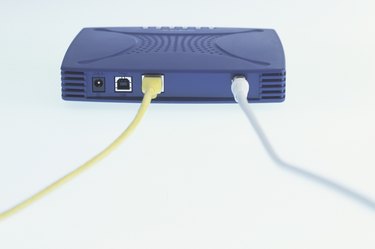
Modern wireless routers can be vulnerable to intruders, either intentionally or accidentally. Many wireless devices automatically seek out and connect to the strongest signal, so it is possible that a neighbor may be connected to your router without his realizing it. Intentional intrusions can range from relatively benign "bandwidth borrowers" to more serious attacks aimed at theft of identity or personal information. The best defense is strong and frequently changed passwords on your router, wireless encryption and monitoring of connected devices.
MAC Address Method
Video of the Day
Step 1
Determine the Media Access Controller address of every authorized wireless device on your network. These devices include printers, laptops, desktops, hand-held devices and any other device which attaches to your network in a wireless mode.
Video of the Day
Each wireless card or embedded controller in these devices has a unique address that identifies it to the network. No two legitimate devices will ever have the same MAC address.
Windows and MAC computers have this information in the control panel for your wireless network device. For other devices, check the manufacturer's instructions for how to locate this address.
The address will be a 12-character field, with each character being a hexadecimal character (0-9 and A-F).
Step 2
Log on to your router as an administrator. Most routers can be addressed by typing 192.168.0.1 into any browser. Supply the correct administrator user name and password.
Check your documentation if you have never changed these from their default values.
Step 3
Find the menu option for attached wireless devices. This will vary depending on the router manufacturer, so check the user manuals.
Step 4
Compare the MAC address for each device listed by the router as being connected with the list of MAC addresses for devices that you expect to be connected. Any MAC address for an unexpected device may be an intruder.
Step 5
Configure your router to only accept connections from known MAC addresses. Most routers offer this feature. Check with your user documentation for instructions.
Other Warning Signs
Step 1
Be alert for any suspicious activity on your network. Most often you will notice this by a slowdown of your network connection speed.
Step 2
Check your router logs for a record of devices connecting and disconnecting from your network. The procedure to access these logs is different depending on the router manufacturer, so check with the user documentation.
These logs typically show connections by MAC address, so be aware of any unexpected addresses.
Step 3
Install software on your network to monitor intrusions. More sophisticated intruders may have the capability to "spoof" MAC addresses, meaning they can set their own MAC address to appear to be a device which legitimately connects to your network.